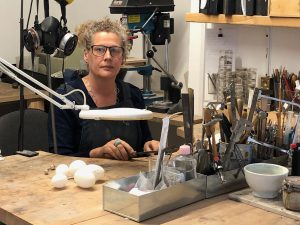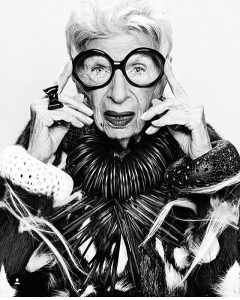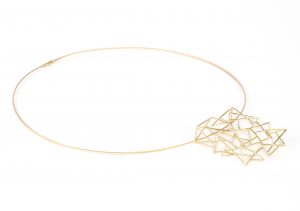Getting to Know Sarah King
Author Sarah King has won numerous jewellery awards, including the Association of Contemporary Jewellery Prize and several commendations from Goldsmiths? Craftsmanship and Design Awards. She has taught at the Birmingham City University, London Metropolitan University and Kent Institute of Art and Design. She currently teaches specialist short courses in the use of plastics and wood in jewellery at Central St Martins, Morley College and West Dean. See what inspires this jewellery maker and more by seeing our interview with Sarah below.
Let us know a bit about yourself, detailing your background, study and training in the jewellery making industry.
I’m primarily self-taught jeweller from an art based background having done a fine art textiles degree at Goldsmiths College, University of London during the YBA era but I was always more of a hands-on maker. I have subsequently taken numerous courses (including a summer school with Cristoph Zellweger, a workshop with Dorothy Hogg, a stone carving week with Charlotte de Syllas, an evening class with Mark Nuell) and see it as an ongoing process as I enjoy experimentation within ideas, materials and techniques.
I have exhibited primarily within craft arena but also encompassing fashion – Kate Moss photographed wearing wood pieces commissioned for W magazine (2004) , Iris Apfel frequently photographed in her bioresin bangles (2014 onwards, see attached photo), white resin pieces published online magazine The Bite (Summer 2012).
My early work was minimalist silver which sold in department stores such as Barneys New York and The Conran Shop. Then for the last 20 years I have been exploring alternative and more sustainable materials for jewellery and pioneered the use of bioresin, a casting resin developed by a German chemist from sunflower seed oil. That took me more into the applied arts world and I was based at Cockpit Arts for 15 years whilst exhibiting and teaching. Pieces have been bought by Public Collections as well as private collectors and until recently I showed regularly at the Chelsea Crafts Fair, Origin and Goldsmiths’ Fair. In 2014 I moved out of the city which has opened up new possibilities allowing for a larger studio space.
Tell us about your work – are there any particular materials or techniques that you favour?
My work is sculptural and tactile and I enjoy techniques that are good for creating interesting forms, such as casting and carving, whether it be in wax, plaster (to create forms for precious metal pieces), wood or bioresin. I like experimenting to see how I can push the possibilities of the materials and their inherent qualities, the reflective qualities of metals, the warmth and sense of time inherent within wood, and the translucency and colour possible in bioresin. I have experimented with technologies such as laser cutting, laser welding and Selective Laser Sintering but I come back to methods that I can have control of in the workshop and that I can change as I work on them.
How would you best describe your design style?
I prefer a pared down aesthetic and play around with the focus and balance of the piece to remove any extraneous details. I like work to be tactile, have a sensuality and a relaxed attitude and to look contemporary but feminine. I try to resist work that shows off its technicality. My clients tend to be arty types, architects, artists and curators who respond to the sensibility and aesthetic of my work rather then it being a status symbol.
Where do you like to get your inspiration from for your pieces?
I find wondering around galleries of abstract art and sculpture are productive places to wonder around sparking off ideas and then I find one piece leading to the next – I miss no longer living on the 56 bus route to Tate Modern! There are certain favourite artists that I always return to – Robert Ryman, Constantine Brancusi, Barbara Hepworth. I’m looking for that visceral feeling I get when seeing a work that grabs me – a lightness of touch or a spatial feeling.
Do you have a piece that you have made which you favour or are particularly proud of?
I don’t think I can pick out one particular piece but there was a group of work that I developed for a solo show in Tokyo in 2003 entitled Light Constructions that was the result of lots of experimentation and to which a still refer back to. It was a series of hand-constructed rings and bangles in silver and white or translucent bioresin. My idea was to explore qualities of light, space, absence and transparency and they were displayed in a white world and lit to accentuate their shadows. It was displayed in the Summer and seemed to resonate strongly with the Japanese audience, with their traditional aesthetic which I’ve always admired, and their sensitivity to the changing seasons.
It was for this show that I developed the pierced hollow bioresin work which became signature pieces, such as the white egg neckpiece in the Craft Councils collection. The work looked very fresh then, as it was before the days of widespread use of 3D printing. See the wonderful award-winning portrait of Iris Apfel wearing my bangles by Guerin Blask.
What is the one item in your jewellery making workshop that you could not live without?
It’s a very modest item but I’m really lost without my vernier gauge as I’m reaching for it all the time to check the size of everything.
What upcoming trends do you see being popular soon?
We are all influenced by the world around us, but I’m not a fan of trends as I want my work to be timeless and for clients to enjoy it over a long period. I wouldn’t want it to look too dated and I like to do my own thing, so I try not to take much notice of them. This attitude seems all the more relevant as awareness around sustainability issues grow. I do enjoy keeping an eye on what new technologies become available.
What is the most valuable lesson you have learnt from your time in the jewellery making industry?
Never underestimate the power of relationships – those with the suppliers and with the clients. Talk to everyone when you are exhibiting as you never know what the conversation might bring or what you will learn.
Do you have any particular advice that you would give to up and coming jewellery designers, or someone interested in getting into jewellery making?
I would say go into the jewellery industry if you are truly passionate about it. Think what really motivates you and why you want to make particular work? Think about where you would place yourself amongst the jewellery already out there. I love having a balance of workshop experimentation which is quite solitary, with the more collaborative aspects of teaching, and working with photographers, graphic and industrial designers.
Time for a bit of fun in our quick-fire round!
Tell us your favourite…
Colour – White
Biscuit – Florentine
Drink – Margarita
Place – Anywhere having an adventure with the family or cultural city break without children!
Animal – Whale
Gemstone – Chalcedony
Food – Japanese
Sport – Wild Swimming
Film – I can’t pick just one!
City – London
And finally, what was your inspiration behind your book and what would you want people to learn from it?
I was commissioned by Judith More of Fil Rouge Press who had spotted how little had been written about wood as a jewellery medium and I immediately agreed as I knew that there was so much exciting work I could include. I wanted to challenge preconceptions and show wood as an innovative and contemporary sculptural medium for jewellery.
I hope the book will broaden knowledge of techniques from low tech to high tech and be a starting point for beginners or a reference for the more experienced makers. I tried to include those key details that I wanted to know when looking at other publications.
I also welcomed the opportunity to explore more sustainable sourcing of woods and other information to enable readers to make informed decisions. It was a particular pleasure to include profiles of prominent studio jewellers (Inni Parnanen, Terhi Tolvanen, Beppe Kessler, and Lina Peterson), all of whom making stunning work without the use of exotic hardwoods.
Although I was originally writing for a UK audience, I’m thrilled to have received messages from readers in Europe, the US and even as far away as Australia…!
Many thanks to Sarah for sharing her insight and jewellery making journey with us
View Creating Jewellery In Wood: Skill Building Projects And Techniques By Sarah King
find out more about this jewellery maker by following them Instagram, Facebook or visit her site
The post Getting to Know Sarah King appeared first on The Bench.
source https://www.cooksongold.com/blog/interview/getting-to-know-sarah-king




Comments
Post a Comment